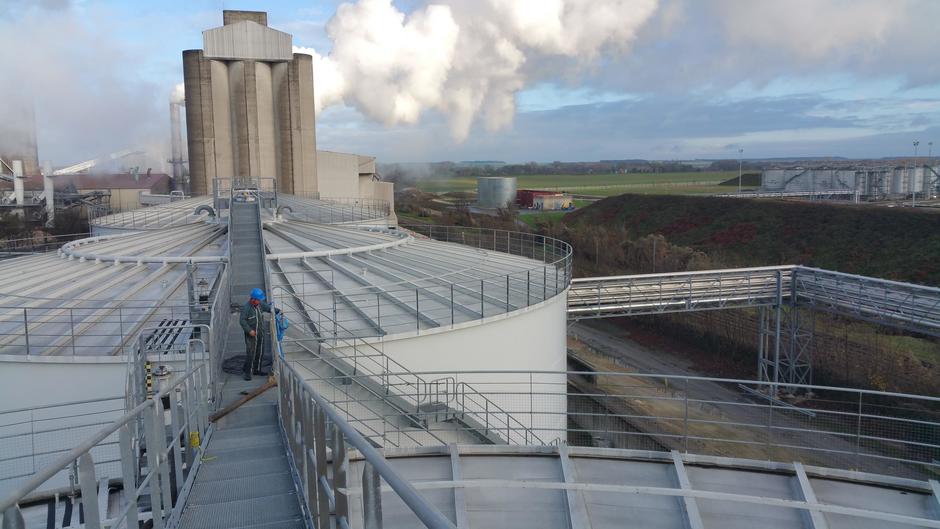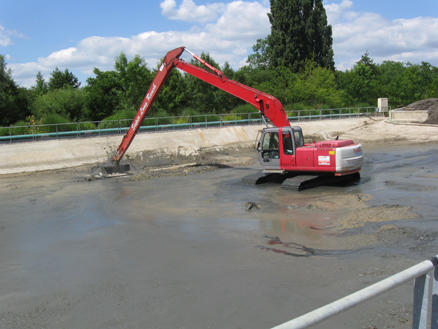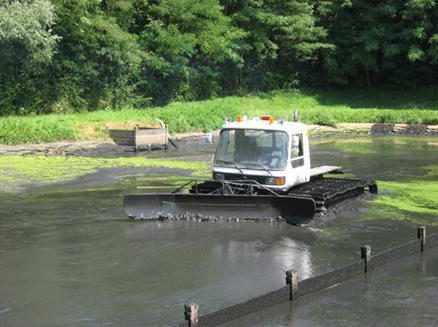SEDE has a full range of resources to help your community when lagooning sewage treatment plants to recover sewage sludge.
Upon completion of each project, SEDE draws up a summary document containing the main data relating to the dredging/spreading operation (date of intervention, start of pumping, work duration, withdrawal date, volume pumped, condition of completion, destination of the sludge, plots spread, etc.).
Water cleaning
This technique doesn’t deteriorate the clay layer that makes the pool watertight. The dredger is launched and retrieved using a crane or mechanical shovel so as not to damage the banks.
The barge operates with a worm screw device, coupled with a suction system used to remove the sewage sludge settled on the bottom.
The barge is operated by radio control from the bank. The operator in charge of cleaning can therefore control the tool in complete safety from the bank.

Advantages of this cleaning technique
This sludge dewatering technique avoids any risk of pollution of the receiving environment caused by a massive discharge of supernatant water during conventional dewatering.
The dewatered sludge, compliant with agricultural recovery, is spread on agricultural plots using slurry spreaders.
Advantages of using a barge
- No suspension of settled matter in the refining basins by water transfer
- No discharge of supernatant water during cleaning
- No use of heavy equipment (excavator, tractor at the edge of the lagoon) leading to degradation of the land, the banks and the clay bottom.
- Work over the entire basin area
- No odours during cleaning
Liquid sludge dewatering
The sludge is pumped, then transported and spread on the plots as part of a spreading plan. Before starting to pump the water, the tank to be cured is taken out of service. The residual supernatant water can be pumped and sent to a second tank.
A bottom sludge removal and stirring operation ensures a homogeneous product, with a dryness of approximately 8%.
The sludge along the banks is removed using an excavator, which will also be used for reprofiling and various ancillary works, if necessary.
The sludge is pumped out and transported by means of slurry spreaders.

Advantages of this cleaning technique
- Reduced operation time: approximately 1 week (except climatic variations)
- No drying time
- Use of common agricultural machinery
- Rapid reuse of the lagoon
- Cleanliness of the site and surroundings
Solid sludge
Solid sludge cleaning is the most economical alternative to composting or landfilling.
The aim is to extract all of the supernatant water and dry the basin to a dryness of around 15% so that the shovel can take up the sludge.
The large arm excavator equipped with caterpillar tracks can operate at any point of the lagoon without damaging the bottom. It allows the removal of sludge from along the banks, their reprofiling and various ancillary works if necessary.
The sewage sludge is then transported in a sealed skip and spread using equipment suitable for this type of sludge.
The approach of cleaning a lagoon or bed planted with "Solid sludge" reeds is similar to an agricultural process of upgrading sewage sludge. The sludge is parched and then transported and applied to the parcels as part of an application plan.

Advantages of this cleaning technique
- Reduced operation time: approximately 4 days (except climatic variations)
- Use of common agricultural machinery
- Rapid reuse of the lagoon
- Cleanliness of the site and surroundings


